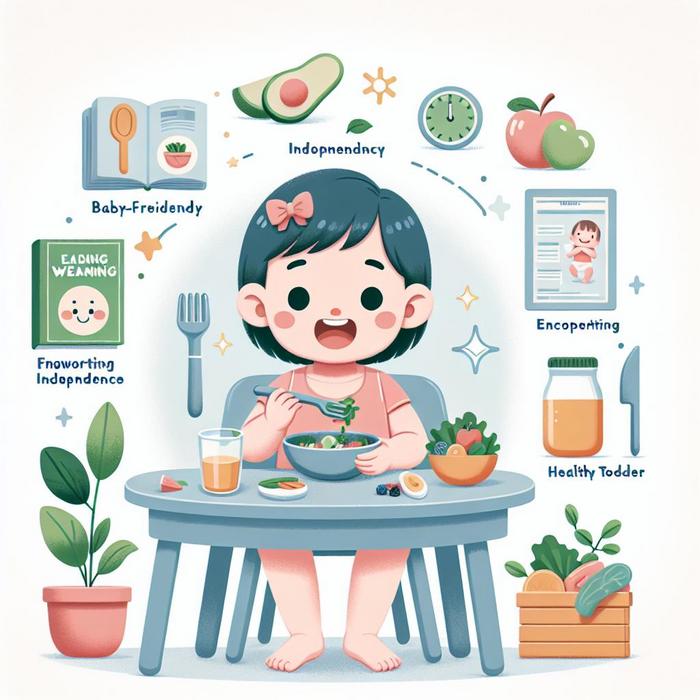Building Skills: Introducing Baby-Led Weaning
Entering the exciting world of solids is a massive milestone for babies and parents alike. An approach growing in popularity is baby-led weaning, which can play a significant role in fostering independence and encouraging toddler self-feeding tips. Unlike traditional feeding methods, baby-led weaning allows your child to control their food intake by ‘feeding’ themselves from the start.
The Process of Baby-Led Weaning
Essentially, baby-led weaning involves offering your toddler a range of wholesome, adequately prepared foods and allowing them to pick, chew, and explore at their own pace. Remember, the goal at the beginning is not about the volume of food consumed but about introducing a variety of textures and flavors.
How Baby-Led Weaning Encourages Independence
Baby-led weaning can be an excellent way to nurture your toddler’s autonomy from an early age. By deciding what, how much, and how quickly they eat, your little one begins to develop a healthy relationship with food. This approach to feeding encourages self-regulation and awareness of hunger and fullness cues, paving the way for healthy eating habits in the future.
Toddler Self-Feeding Tips: Getting Started With Baby-Led Weaning
Embracing baby-led weaning can feel a bit overwhelming, particularly if your toddler is your first child. However, here are some valuable toddler self-feeding tips to help you start:
- Wait until your child shows signs that they are ready. This usually happens around six months when they can sit up unassisted and bring objects to their mouth independently.
- Offer a variety of textures and flavors. Foods should be cut into manageable sizes and should be soft enough for your child to handle and chew safely.
- Practice patience. Try to resist the urge to rush or prompt your child to eat faster. Allow them to explore their food at their own pace.
For more comprehensive guidance and best practices for introducing solid foods, visit our detailed guide on feeding multiple babies.
Fostering Autonomy: Letting Go of Supervised Feeding
After they’ve mastered baby-led weaning, it’s time to take the next step: encouraging your toddler to self-feed. Fostering autonomy in toddlers involves gradually reducing the hands-on assistance you provide during mealtime, which can sometimes be emotionally challenging for parents. However, learning to let go is vital in supporting your child’s growing independence.
Encouraging Independence: A Balancing Act
Encouraging independence is a delicate balancing act and one that’s different for every child. While it’s crucial to offer opportunities for self-expression and decision-making, it’s also important to provide guidance and support. As a parent, you’re their secure base from which they can confidently explore the world, including the world of food.
For more information on how to encourage your child back to nursing and to manage breastfeeding strikes, visit our resource at biomimetic-feeding.
Embracing the Mess: The Role of Play in Self-Feeding
A major part of self-feeding is allowing your child to make a bit of a mess. This may seem counterintuitive, but allowing your toddler to play with their food can actually encourage self-feeding skills. As they interact with different textures, they’re not only learning about their food, but also developing motor skills.
Remember, fostering independence is a journey and not an overnight process. Be patient, offer support, and ensure your child feels loved and secure. As they grow more confident and capable, they’ll thank you for the autonomy you’ve provided them.
The Role of Parents in Nurturing Self-Feeding Skills
Parents play a critical role in nurturing their child’s self-feeding skills. They provide a supportive environment for their child, set a positive example, and respond sensitively to their child’s cues of hunger and satisfaction. How parents respond to messy eating, how they help their child cope with new flavors and textures and their patience during mealtimes can considerably impact their child’s self-feeding ability and independence.
To gain more insights on nurturing your child’s self-feeding skills, click here: Encouraging Feeding Independence for Children.
Benefits of Baby-Led Weaning and Independence
Baby-led weaning offers a multitude of benefits for your growing child. It fosters self-confidence, improves hand-eye coordination, and develops their chewing skills. Moreover, it’s a hands-on sensory experience that could let your child enjoy mealtime more and result in a better acceptance of solid foods in the long run.
Tips for Encouraging Autonomy Through Meal Planning
Involving your child in meal preparation can offer wonderful opportunities for them to exercise their independence. Simple tasks like washing vegetables, stirring ingredients, or setting the table promote responsibility and a sense of accomplishment. Furthermore, involving children in the cooking process can stimulate their curiosity about food and encourage them to try new dishes they helped prepare.
Considerations When Introducing Solid Foods
Introducing your child to solid foods can be exciting but also challenging. It’s vital to avoid potential choking hazards and to ensure the foods offered are appropriate for your child’s developmental level. Also, pay attention to potential allergic reactions when introducing new foods. Always follow your pediatrician’s guidance when it comes to introducing solids to your baby.
You can learn more about teaching self-feeding skills to your kid from this link: Promoting Independence: Self Help Skills.
Reaping the Rewards of Your Child’s Independence
When your child starts feeding themselves, it’s a triumphant moment. Yes, mealtimes might be a bit messier, but the rewards of building independence far outweigh a few crumbs on the floor. The confidence your child gains from mastering self-feeding will serve them well as they continue to explore their world, learn new skills, and grow into an independent individual.
For more tips on how to foster autonomy and self-confidence in your child, visit this informative site: How to Foster Your Child’s Autonomy and Build Self-Confidence.
Shaping Future Food Preferences
Introducing a variety of flavors and textures early in life can shape your child’s future food preferences. Offering a diverse range of wholesome foods can create a lifelong appreciation for healthy eating, aiding in the prevention of future dietary problems.
Find more help on teaching your infant to feed themselves here.

